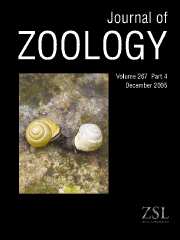Crossref Citations
This article has been cited by the following publications. This list is generated based on data provided by
Crossref.
Dickinson, Hannah C.
Fa, John E.
and
Lenton, Stuart M.
2001.
Microhabitat use by a translocated population of St Lucia whiptail lizards (Cnemidophorus vanzoi).
Animal Conservation,
Vol. 4,
Issue. 2,
p.
143.
Rowe, Graham
Dickinson, Hannah C.
Gibson, Richard
Funk, Stephan M.
and
Fa, John E.
2002.
St Lucia Whiptail Lizard Cnemidophorus vanzoi (Sauria: Teiidae) microsatellite primers.
Molecular Ecology Notes,
Vol. 2,
Issue. 2,
p.
124.
Rogovin, K. A.
and
Semenov, D. V.
2004.
The Toad-Headed Agama Phrynocephalus guttatus (Reptilia: Agamidae): The Correlates of Survival in a Translocated Population in the Southwestern Kalmyk Republic.
Russian Journal of Ecology,
Vol. 35,
Issue. 6,
p.
389.
Wahbe, Tanya R
Bunnell, Fred L
and
Bury, R Bruce
2004.
Terrestrial movements of juvenile and adult tailed frogs in relation to timber harvest in coastal British Columbia.
Canadian Journal of Forest Research,
Vol. 34,
Issue. 12,
p.
2455.
Funk, Stephan M.
and
Fa, Julia E.
2006.
Phylogeography of the endemic St. Lucia whiptail lizard Cnemidophorus vanzoi: Conservation genetics at the species boundary.
Conservation Genetics,
Vol. 7,
Issue. 5,
p.
651.
Soares, Ana Hermínia B.
and
Araujo, Alexandre F. B. de
2008.
Experimental introduction of Liolaemus lutzae (Squamata: Iguanidae) in Praia das Neves, State of Espírito Santo, Brazil: a descriptive study 18 years later.
Revista Brasileira de Zoologia,
Vol. 25,
Issue. 4,
p.
640.
Connolly, Joanne D.
and
Cree, Alison
2008.
Risks of a late start to captive management for conservation: Phenotypic differences between wild and captive individuals of a viviparous endangered skink (Oligosoma otagense).
Biological Conservation,
Vol. 141,
Issue. 5,
p.
1283.
Kacoliris, Federico P.
Berkunsky, Igor
and
Williams, Jorge D.
2009.
Methods for Assessing Population Size in Sand Dune Lizards (Liolaemus Multimaculatus).
Herpetologica,
Vol. 65,
Issue. 2,
p.
219.
Raia, Pasquale
Guarino, Fabio M
Turano, Mimmo
Polese, Gianluca
Rippa, Daniela
Carotenuto, Francesco
Monti, Daria M
Cardi, Manuela
and
Fulgione, Domenico
2010.
The blue lizard spandrel and the island syndrome.
BMC Evolutionary Biology,
Vol. 10,
Issue. 1,
Li, C.
Lian, X.
Bi, J.
Fang, H.
Maul, T.L.
and
Jiang, Z.
2011.
Effects of sand grain size and morphological traits on running speed of toad-headed lizard Phrynocephalus frontalis.
Journal of Arid Environments,
Vol. 75,
Issue. 11,
p.
1038.
Nussear, K. E.
Tracy, C. R.
Medica, P. A.
Wilson, D. S.
Marlow, R. W.
and
Corn, P. S.
2012.
Translocation as a conservation tool for Agassiz's desert tortoises: Survivorship, reproduction, and movements.
The Journal of Wildlife Management,
Vol. 76,
Issue. 7,
p.
1341.
Attum, Omar
Cutshall, Christian D.
Eberly, Kelly
Day, Hannah
and
Tietjen, Bill
2013.
Is there really no place like home? Movement, site fidelity, and survival probability of translocated and resident turtles.
Biodiversity and Conservation,
Vol. 22,
Issue. 13-14,
p.
3185.
Brown, D. S.
Burger, R.
Cole, N.
Vencatasamy, D.
Clare, E. L.
Montazam, A.
and
Symondson, W. O. C.
2014.
Dietary competition between the alien Asian Musk Shrew (Suncus murinus) and a re‐introduced population of Telfair's Skink (Leiolopisma telfairii).
Molecular Ecology,
Vol. 23,
Issue. 15,
p.
3695.
Attum, Omar
and
Cutshall, Christian D.
2015.
Movement of translocated turtles according to translocation method and habitat structure.
Restoration Ecology,
Vol. 23,
Issue. 5,
p.
588.
Fitzgerald, Lee A.
Treglia, Michael L.
Angeli, Nicole
Hibbitts, Toby J.
Leavitt, Daniel J.
Subalusky, Amanda L.
Lundgren, Ian
and
Hillis‐Starr, Zandy
2015.
Determinants of successful establishment and post‐translocation dispersal of a new population of the critically endangered St. Croix ground lizard (Ameiva polops).
Restoration Ecology,
Vol. 23,
Issue. 6,
p.
776.
Switzer, David
and
Angeli, Nicole Frances
2016.
Human and Non-Human Migration: Understanding Species Introduction and Translocation through Migration Ethics.
Environmental Values,
Vol. 25,
Issue. 4,
p.
443.
Ari Janiawati, Ida Ayu
Kusrini, Mirza Dikari
and
Mardiastuti, Ani
2016.
Structure and Composition of Reptile Communities in Human Modified Landscape in Gianyar Regency, Bali.
HAYATI Journal of Biosciences,
Vol. 23,
Issue. 2,
p.
85.
Daltry, J. C.
Lindsay, K.
Lawrence, S. N.
Morton, M. N.
Otto, A.
and
Thibou, A.
2017.
Successful reintroduction of the Critically Endangered Antiguan racer Alsophis antiguae to offshore islands in Antigua, West Indies.
International Zoo Yearbook,
Vol. 51,
Issue. 1,
p.
97.
Angeli, Nicole F.
Lundgren, Ian F.
Pollock, Clayton G.
Hillis‐Starr, Zandy M.
and
Fitzgerald, Lee A.
2018.
Dispersal and population state of an endangered island lizard following a conservation translocation.
Ecological Applications,
Vol. 28,
Issue. 2,
p.
336.
Rotger, Andreu
Tenan, Simone
Igual, José‐Manuel
Bonner, Simon
and
Tavecchia, Giacomo
2023.
Life span, growth, senescence and island syndrome: Accounting for imperfect detection and continuous growth.
Journal of Animal Ecology,
Vol. 92,
Issue. 1,
p.
183.

